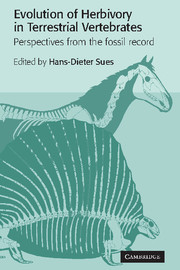Book contents
- Frontmatter
- Contents
- List of contributors
- Preface
- 1 Herbivory in terrestrial vertebrates: an introduction
- 2 Herbivory in late Paleozoic and Triassic terrestrial vertebrates
- 3 Prosauropod dinosaurs and iguanas: speculations on the diets of extinct reptiles
- 4 The evolution of sauropod feeding mechanisms
- 5 Plant-eaters and ghost lineages: dinosaurian herbivory revisited
- 6 Dental constraints in the early evolution of mammalian herbivory
- 7 Patterns in the evolution of herbivory in large terrestrial mammals: the Paleogene of North America
- 8 Origin and evolution of the grazing guild in Cenozoic New World terrestrial mammals
- Taxonomic index
- Subject index
4 - The evolution of sauropod feeding mechanisms
Published online by Cambridge University Press: 22 October 2009
- Frontmatter
- Contents
- List of contributors
- Preface
- 1 Herbivory in terrestrial vertebrates: an introduction
- 2 Herbivory in late Paleozoic and Triassic terrestrial vertebrates
- 3 Prosauropod dinosaurs and iguanas: speculations on the diets of extinct reptiles
- 4 The evolution of sauropod feeding mechanisms
- 5 Plant-eaters and ghost lineages: dinosaurian herbivory revisited
- 6 Dental constraints in the early evolution of mammalian herbivory
- 7 Patterns in the evolution of herbivory in large terrestrial mammals: the Paleogene of North America
- 8 Origin and evolution of the grazing guild in Cenozoic New World terrestrial mammals
- Taxonomic index
- Subject index
Summary
Introduction
Sauropods were gigantic, long-necked, herbivorous dinosaurs, which dominated many Jurassic and Cretaceous terrestrial faunas. First appearing in the fossil record during the Early Jurassic, they rapidly achieved a nearly global distribution, with apparent peaks in diversity and abundance in the Kimmeridgian, Hauterivian–Barremian, and Campanian–Maastrichtian (McIntosh 1990; Weishampel 1990; Hunt et al. 1994; Barrett 1998).
Early discoveries of poorly preserved sauropod material were interpreted as the remains of marine crocodiles (Owen 1841, 1842). Better preserved specimens (Cetiosaurus) from the Middle Jurassic of Oxfordshire, however, allowed Phillips (1871:294) to recognize that these animals were terrestrial dinosaurs which probably ate plants. This discovery was soon overshadowed by spectacular material from the western United States (Cope 1877a, b; Marsh 1877a, b, 1878, 1879), prompting Marsh (1878) to create the new dinosaurian subgroup Sauropoda. The retracted nostrils in the skull of Diplodocus (Marsh 1884), and the gigantic size of these animals, led many workers to conclude that sauropods must have been aquatic (Cope 1878; Marsh 1883; Hatcher 1901; Hay 1908). This ‘aquatic’ hypothesis had an important effect on interpretations of sauropod feeding habits and mechanisms. If such gigantic animals were restricted to food available in or near bodies of water, they probably ate soft aquatic vegetation or invertebrates (Hay 1908; Holland 1924; Haas 1963). This view was seemingly supported by the ‘weak and inefficient’ masticatory apparatus of most sauropods, especially the ‘tooth-comb’ of Diplodocus, which could have been used for straining items from the water.
- Type
- Chapter
- Information
- Evolution of Herbivory in Terrestrial VertebratesPerspectives from the Fossil Record, pp. 79 - 122Publisher: Cambridge University PressPrint publication year: 2000
- 98
- Cited by



